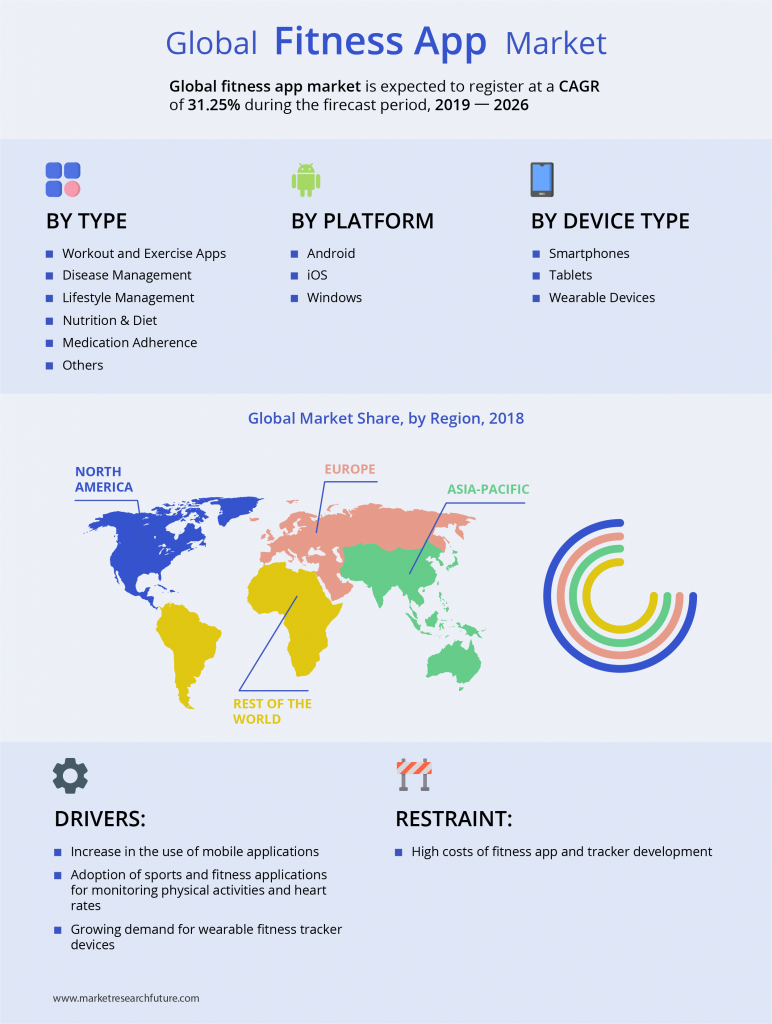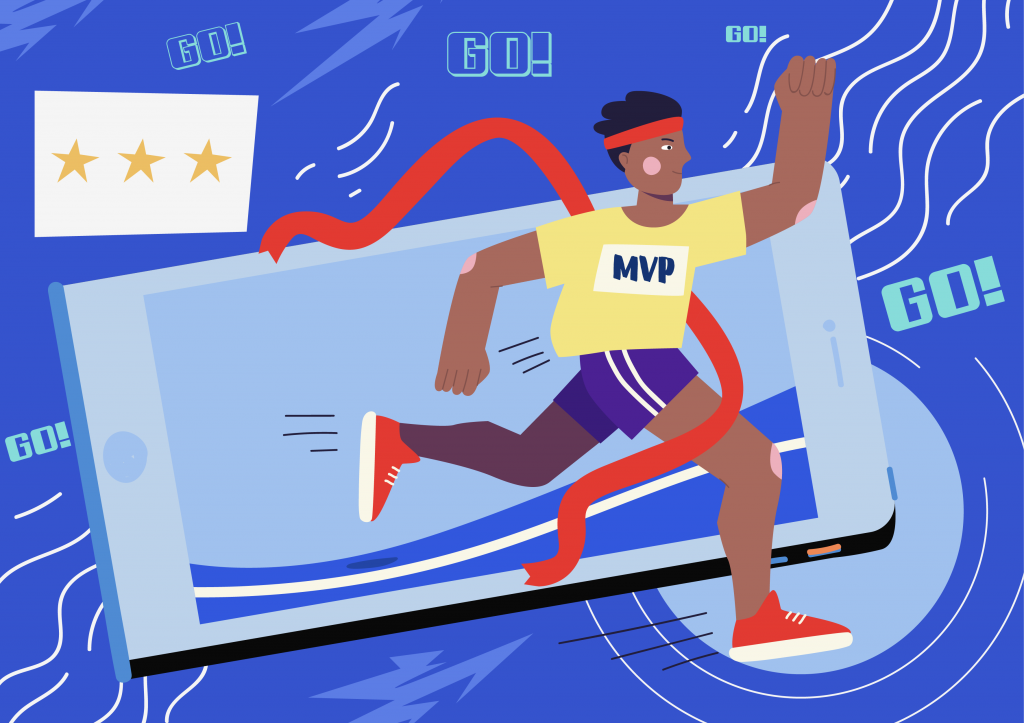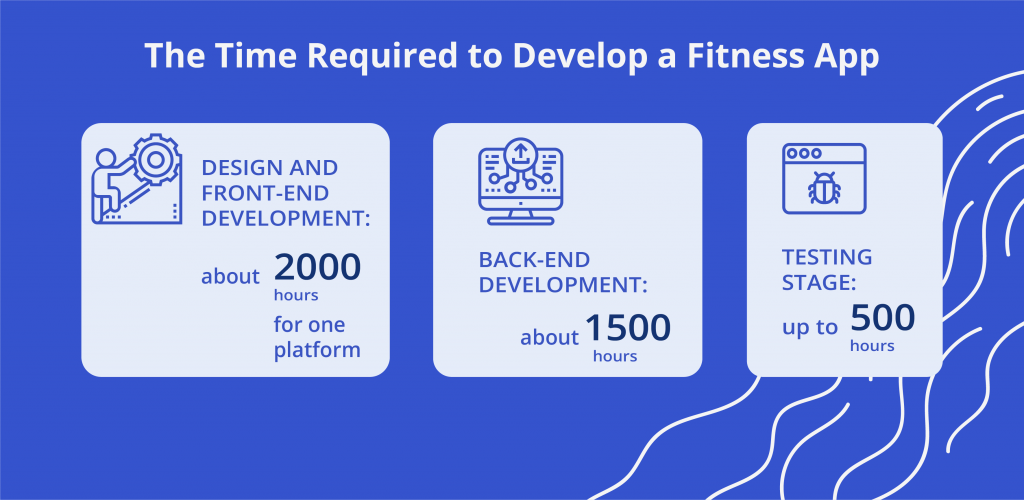How to Build an MVP for a Fitness Application

The COVID-19 pandemic, while challenging to many businesses and industries, has seemed to be nothing but beneficial to the fitness apps market. Due to quite drastic lifestyle changes, more and more people are concerned about their health, keeping fit, and adopting healthy habits. As a result, health and fitness app downloads grew by 46% between the first and second quarters of 2020.

Entrepreneurs and fitness coaches may also be tempted to jump on the bandwagon with a new mobile app. If you are one of them, the best way to test your concept quickly and cost-effectively is to build a minimum viable product (MVP). A well-made MVP that covers the users’ needs while showcasing your original ideas may potentially become the basis for a future profitable startup.
Today, we will outline the steps to build an MVP for a fitness app and the most important features it should have.
Things to Consider Before the MVP Development Process
The following activities will help you better define your MVP concept and eventually create a fitness app that brings real value to users.
Research Your Competitors and Identify Your Unique Value Proposition
Profound market research will help you understand the present state of affairs in this industry and hopefully help to develop ideas on how to make an MVP for a fitness app that stands out from the competitors.
Profound research is a great method to:
- Better understand the present products on the market
- make a detailed comparison of the top-rated applications and understand why they are doing well
- detect the stronger points of your competitors which you should consider implementing, as well as identifying their weak points
- locate opportunities
- develop insights about making your fitness app better
- identify the unique value proposition (UVP) of your fitness app
For example, developing an app specifically for working out at home may have great potential. The home workout niche is not yet oversaturated, with most apps focusing on gym-goers and users who don’t have exercise equipment at home. Demand for this type of app is growing due to the pandemic, and some countries even sponsor such applications to help reduce COVID-19 virus infection rates.
Select the Type of Your Fitness App
Choose the concept of your fitness app based on your findings and business needs. Define the problem you want to solve and build a specifically-tailored solution for it.
For example, you may want to follow the examples of major sportswear companies, celebrities, or other brands and build:
- an app increasing your existing brand awareness, as Adidas or Nike have done
- a celebrity fitness app, whose content will be provided or endorsed by influencers (Centr by Chris Hemsworth is an example)
- a fitness app featuring you or another fitness coach promoting original programs, like SCULPT formulated by the certified personal trainer and nutritionist Ken Rawlins
- fitness studio app that will help you sell sports equipment or fitness services
Here are some of the popular fitness app categories that you might choose from:
- Workout applications that offer various sets of exercises for training the user’s body
- Sports activities tracking apps that show details of a user’s sports activities
- Meal planner programs for tracking calories, planning daily meals, and suggesting healthy options
- Lifestyle applications dedicated to specific activities like yoga, meditation, etc.
The types of apps may also be differentiated based on the platform and specific devices. You can develop a fitness app for Android or iOS smartphones, tablets, smartwatches, etc.
Once you’ve defined the type of your future fitness app, it’s time for an in-depth study of your target audience.
Define Your Target Audience
Choosing MVP features is always tricky since you will want to address critical areas to attract potential users to your product. A deep understanding of who your target audience is can help you choose the right functionalities for your app, create different levels (beginner, intermediate, and advanced), and curate content specifically targeted for the users’ needs.
Determine Your Main Advantages and Choose Features
Since your task is to create a unique fitness application that will be better than your rivals’, the very first thing you can do is to make a detailed list of your future app’s benefits while answering the fundamental question “Why should people use it?”
Answering these questions will help you determine which features should be included in your fitness app and how to ensure flawless app navigation. For example, if you create a fitness app for busy people wanting to incorporate some physical activity into their routine, you can create short workout programs and send daily reminders about each user’s progress. When creating an app for runners preparing for a marathon, you would need to include more detailed, professional advice and much more intense workout programs, and so forth.

Choosing the Features for Your Fitness App MVP
The core MVP features for a fitness application include, but should not be limited to:
#1 Registration & Personal Account
Each fitness app should have an intuitive registration process and easy-to-navigate personal account with all the information users want to track during the workout progress. That might include the current weight, height, goals, and some specific health information. For the app owners, such user data can present insights into the audience’s pains, goals, and overall progress, which is critical for further development and improvement of workout plans.
#2 Social Media Integration
Over 73% of marketers believe social media are really effective for business promotion. By allowing users to share their workout plans and achievements on social media, a business can gain additional exposure and promotion.
#3 Workout Menu, Search & Filters
Сreate various workout sets for different body parts, fitness inventory, or levels of complexity. This will help your users to adjust the exercises to their goals, preferences, and needs.
#4 Stats
Nothing can motivate people better than detailed statistics of their progress. Showing the achievements and reminding about missed workouts makes users regularly return to the app to continue their fitness journey.
The analysis of data about the level of users’ physical fitness enables app owners to adjust the workout plans for different audience segments.
#5 Third-Party Services & Devices Integration
You may need to retrieve data about users’ physical activity from the Health app that consolidates statistics from activity trackers like Apple Watch or Fitbit. The gathered information can help you create more personalized workout plans. However, note that you would need at least a month for creating integration with each of these devices.
#6 Push Notifications
This feature is essential for reminding users about the scheduled workouts, informing them about fresh workout sets and app’s new features, sending valuable promotions, and otherwise keeping your customers engaged and interested.
#7 Payment System Integration
When your app has a large audience and high download rates, you will be able to offer premium workout sets and more advanced app features. You need to integrate payment gateways that are secure and easy to use for your audience. Stripe, PayPal, and Braintree are some of the most popular options out there, but you need to make your choice based on the getaway’s fees for each transaction and the convenience for your target audience.
When entrepreneurs build MVP for apps of any kind, they also have to plan unique features or at least functionalities that will distinguish them from the competition. The latter may include:
#1 Coach-On-Demand
This option will attract new users and meet the expectations of those existing users who want personalized workouts with a professional coach.
#2 Workout Builder
This feature allows professional coaches or enthusiasts to create and publish their own workouts. To make the exercises more personalized, it is also important to include algorithms that would analyze users’ current stats and goals and would adjust the training accordingly. This way, your app will provide safe workouts and gather more happy customers.
#3 Educational Content
To ensure that the users make the most from the fitness app and your business retains customers, you should also include features to teach users how to exercise correctly and not avoid injuries. The app can show which group of muscles can be trained with each move and analyze these techniques for an effective workout.
#4 Gamification
To motivate users to exercise with your app daily and to show that you care about their progress, you may offer them a contest or challenges, provide valuable gifts, and make the workouts more interactive. Gamification is also a powerful tool for reaching younger audiences.
#5 Live Streaming/Video on Demand
For a gym app, including a class streaming option can be a great idea. It will be much easier to organize the training process and control the completion. Combined with the other features, it can be transformed into a huge workout and fitness system.
Time & Resources Needed to Build MVP for App in the Fitness Industry
The approximate time you need for launching your fitness app encompasses the time you may spend on research, analysis, and planning, design, implementation of the selected MVP features, and testing of the resulting product.
Below is an estimate of developing an app with the features discussed above:

The final cost of the MVP development process will depend on:
- The complexity of your app’s functionality
- Complexity of third-party integrations
- Operating system you prefer
- Level of expertise of your software developers and other team members
- Form of cooperation with the software developers
- Location of your software development team
… and possibly other factors. If you want to get a cost estimation for your project, please don’t hesitate to book a consultation with our team. Our experts will discuss your project in detail and suggest solutions.
Example of Creating MVP for a Fitness App
Let’s have a look at Liftsync, a fitness application for athletes and coaches developed by Alternative-spaces. The app targets teams as a whole unit, so it can be easily used by universities, colleges, school teams, etc.
The Alternative-spaces team conducted profound market research and competitor analysis to understand how team training should be tracked and what critical features should be included. The information was immensely helpful when we were drawing wireframes, developing a user flow map, creating an interactive prototype, and working on the app design.
The app’s core features include:
- training and workout management
- workout metric analytics
- easy profile management
- group messages
Thorough research helped the team to create high-quality multi-platform software with intuitive navigation that helps to structure massive amounts of information.
To Recap
Building a minimum viable product is the fastest and most cost-effective way to check whether your fitness application will be valuable and in demand. However, even an MVP development process should be preceded by user research and analysis of competitors. With a well-planned strategy, a detailed list of indispensable and nice-to-have features targeting a user pool as large as possible, and a reliable team of developers, your chances for launching a successful new fitness app will increase significantly.
Now that you know how to build an MVP for a fitness app and are determined to proceed, it’s time to look for a team that can do it for you. Besides the designers’ and programmers’ hourly rates, you will need to look at their expertise and experience in building effective solutions for the mobile fitness industry.
If you are looking for experienced developers, UX/UI experts, and project managers to help you test your idea or build a full-fledged fitness application without overspending your resources, please feel free to contact Аlternative-spaces. With an individual approach for each case, we are always here to consult and assist startups!
If you are looking for experienced developers, UX/UI experts, and project managers to help you test your idea or build a full-fledged fitness application without overspending your resources, please feel free to contact Alternative-spaces. With an individual approach for each case, we are always here to consult and assist startups!
Content created by our partner, Onix-systems.
 Home
Home